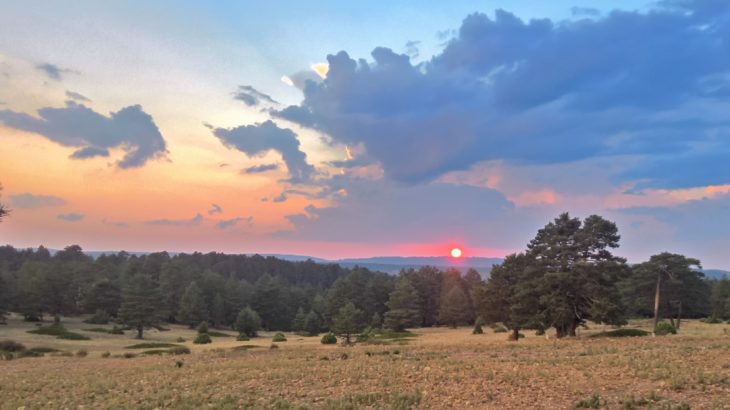Monday 13 August – from Göttingen (DE) to Orange (FR) = 1117 km
Tuesday 14 August – from Orange (FR) to Sant Cugat del Vallès (ES) = 446 km
Wednesday 15 August – from Sant Cugat del Vallès (ES) to Cuevas de Cañart, Maestrazgo (ES) = 322 km
Friday, 17 August – from Cuevas de Cañart (ES) to Tramacastilla, Sierra de Albarracín (ES) = 172 km
This is the longest car trip I have ever made in my life. During the 2057 km at the wheel I was able to observe through the windscreen a landscape of changing vegetation and topography, as well as the different road signs and the varying behaviour of other “road users” depending on the country you are passing through. After the stops described at the beginning of the post I finally arrived on Friday 17 August in the Albarracín Mountains – the Sierra de Albarracín.
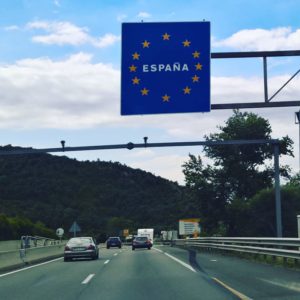
Spanish-French border – La Jonquera
Being accustomed to travelling by plane – when you have grown up in Tenerife, you don’t have many alternative means of travel – crossing a good part of the continental geography and suddenly coming face to face with the Mediterranean Sea is not only something special, but it also provides you with a perception, an understanding of Europe (which can also be extrapolated to the notion of the European Union, which is not the same thing) that underlines how connected and close we all really are. Crossing the border from France into Spain by road is quite emotional. You no longer hear it only on the radio, just as you have all your life, that today there is the classic traffic jam at La Jonquera, but there you are at the wheel and you drive under the sign that says “Spain”. A curious feeling, for me at least.
My final destination on this long journey is specifically the village of Tramacastilla, in the west of the Province of Teruel, at an altitude of about 1260 m and with roughly 100 registered inhabitants. This is one of the municipalities of the Sierra de Albarracín, where the headquarters of ASIADER (Association for the Integral Development of the Sierra de Albarracín) is located, the organisation I am working with to develop the study included in my doctoral project. After passing through the famous Albarracín tunnel I am greeted with open arms by an entirely female team. They, together with others from the town, have helped me to look for accommodation, etc. and so to be able to get settled in, both in the town and the Sierra.
And believe me, it is not the same reading and hearing that there are areas of Spain that have fewer than 8.5 inhabitants /km2, and experiencing it in person.
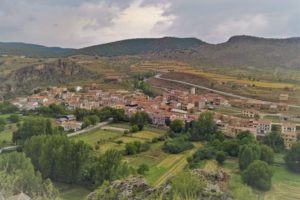
Tramacastilla from above
Here, the provincial capital – Teruel – with approximately 35,500 inhabitants, is an hour’s drive away along a winding road and the vast majority of the villages are under 200 inhabitants in size. That’s taking into account the dubious statistical data from the census. A situation particular to Spain where everyone knows that the population registered in villages is much greater than the population that really lives in them all year round. In Germany you can be given a severe fine if within two weeks of moving to a place you do not register with the corresponding local authority. Can somebody explain to me why this is not regulated at European level; wouldn’t some reliable statistics be useful to plan better?
Matters such as the connection to the mobile internet network and above all to the landline network leave a lot to be desired. The basic services of education, health and basic necessities are acceptably covered, although with distances and times comparatively greater than the normal ones where I live in Germany (except small, rural primary schools with children of all ages that exist in almost every village). In short, it is once-in-a-lifetime experience to reside in a tract of land with characteristics like these.
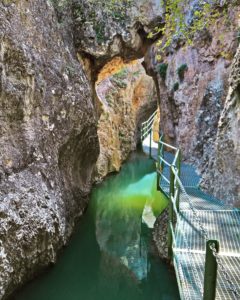
De la Hoz Ravine – From Calomarde to Frías de Albarracín
On the other hand, it is spoilt for resources. To me, the landscape stands out above anything else. The ochre and sometimes reddish colour of the huge rock walls that you find around every corner is imposing. The narrow canyons conveying rivers of crystal-clear waters are my favourites. Then there are the sweeping pine forests on the high ground. But there is also an historical, cultural and architectural heritage, not only in Albarracín capital but in all the villages of the Sierra. Pines, mushrooms, hunting, adventure sports, truffles, traditions linked with the farming heritage … but let’s keep it brief: I’m not going to tell you everything in one post. The idea is to reveal the region little by little.
In any case, I have been able to confirm that the very mediatic subject of “depopulation” that I introduced in the previous post continues to be a hot topic. In fact, with regard to this I was interviewed in the newspaper and they included that in the title, even though I did not use the “dreaded word” very much either. A lot of people are quite fed up with hearing and reading about depopulation and seeing little institutional support at many levels. Unfulfilled promises, certain political representatives who like to see their photos in the newspapers, … “Less gabbing and more doing…” is what goes through the minds of those residents affected. Such is the level that the phenomenon has reached on the media scale, that finally even an IKEA advert has come out, filmed in collaboration with the “Teruel Existe!” initiative and which you can watch below.
The processes responsible for depopulation have been going on for centuries and began, among other things, with the confiscation (privatization) of common land during the 16th and 17th centuries, then continued with the commodification and monetarization of agricultural production and the proletarization of the peasantry in the 18th and 19th centuries, was then consolidated with the irruption of the logic of capitalism and its technological-industrial cycles and stretches to the present day with the enforced immersion of all rural areas of the planet in the context of neoliberal globalization. This is what Luis del Romero Renau affirms in his recent and highly recommendable book: “Depopulation and abandonment of rural Spain. The defeated impossible“: people have been gradually pushed out of the countryside by the method of hindering their way of life and sustenance. The current situation should not surprise us.
And yes, right now I am in what they call the “ground zero” of depopulation: right among the provinces of Teruel, Cuenca and Guadalajara.
But I have not come this far to contribute to the dismal discourse of imminent and inevitable apocalypse
(see “Salvados” Nr 88 [Spanish TV documentary series]). Nor are we going to examine everything through pink-coloured glasses. There are palpable injustices that limit to a scandalous extent the opportunities of a person from the Sierra in comparison with those of a resident in, for example, the Madrid street of the same name. *Calle Serrano in Madrid, synonym of luxury,exclusive shops, art galleries, etc. This is a right that has to be asserted and a claim that has to be demanded until things change!
What I want to focus on are examples, people and initiatives that demonstrate that “another rural world is possible”. For example in the case of …
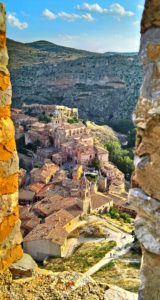
Albarracín seen from the top of its defensive walls
… a semi-public initiative with a solid institutional partnership and bold key actors who, for over 20 years have been restoring and refurbishing (and in comparison with private initiatives) with limited funds, a unique architectural ensemble, turning it into a magnet to attract tourism in one of the most rural and remote parts of the country. In the course of their work they have been able to establish the place as a national reference in training for restorers which attracts many people who receive training throughout the year in the locality. Finally, they have been able to set up a cultural programme that is a reference providing high quality offerings to the people in the Sierra.
… a public-private company in the circular bio-economy and a guarantor of quality employment based on one of the most abundant and valuable resources of the Sierra: timber. In its factory, quality material is transformed into different products with low and high added value, from industrial pallets to creative merchandising products made of wood. The wood leftovers are transformed into pellets to heat the cold winters, as well as forming the raw input for a biomass plant. The latter also takes in dung from livestock and agricultural waste to produce methane by fermentation which is then burned to obtain electricity and heat. With the abundant heat left over from the process, an industrial laundry for the hotel trade has been incorporated which provides its services to the ever increasing number of rural hotels and restaurants in the area.
… an informal group of entrepreneurs working in rural tourism, nature and adventure sports that with great dedication and effort are generating a differentiating brand for the region as a tourist destination for top athletes (and their families, of course), for professional photographers (ditto) and for lovers of the untamed nature and tranquillity to be found in these parts. From recognizing the potential of the Sierra, by way of putting in the hard work, keeping the conviction that the right promotion and proper positioning are necessary, then managing to get those visitors with very special expectations to come and stay here and be amazed by the offer to the extent that they themselves take care of “word of mouth publicity” … these are all stages in the race.
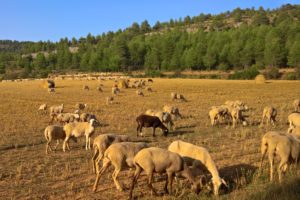
Merino sheep and some goats near the Molino de San Pedro (St. Peters Mill)
I have to confess that in some of these examples, I have included some of my own imaginings and they are not all 100% real. But it is never too late to use some imagination to deal with depopulation. There are many existing success stories and many others still to come. What are we all waiting for to get them going?
In the next post I hope to tell you more about my experiences from ASIADER, in the Sierra de Albarracín and in Teruel, Aragón. I’ll leave you with a fantastic video of “Love Albarracín” to make you envious about the spectacular mountain landscapes.
Stay tuned!
